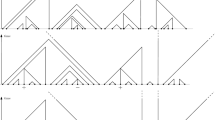Abstract
Consider the system of particles onℤd where particles are of two types—A andB—and execute simple random walks in continuous time. Particles do not interact with their own type, but when anA-particle meets aB-particle, both disappear, i.e., are annihilated. This system serves as a model for the chemical reactionA+B→ inert. We analyze the limiting behavior of the densitiesρ A (t) andρ B (t) when the initial state is given by homogeneous Poisson random fields. We prove that for equal initial densitiesρ A (0)=ρ B (0) there is a change in behavior fromd⩽4, whereρ A (t)=ρ B (t)∼C/t d/4, tod⩾4, whereρ A (t)=ρ B (t)∼C/tast→∞. For unequal initial densitiesρ A (0)<ρ B (0),ρ A (t)∼e −c√l ind=1,ρ A (t)∼e −Ct/logt ind=2, andρ A (t)∼e −Ct ind⩾3. The termC depends on the initial densities and changes withd. Techniques are from interacting particle systems. The behavior for this two-particle annihilation process has similarities to those for coalescing random walks (A+A→A) and annihilating random walks (A+A→inert). The analysis of the present process is made considerably more difficult by the lack of comparison with an attractive particle system.
Similar content being viewed by others
References
A. A. Ovchinikov and Ya. B. Zeldovich,Chem. Phys. 28:214 (1978).
D. Toussaint and F. Wilczek,J. Chem. Phys. 78:2642 (1983).
M. Bramson and J. L. Lebowitz,Phys. Rev. Lett. 61:2397 (1988);62:694 (1989).
S. Redner and K. Kang,Phys. Rev. Lett. 51:1729 (1983); K. Kang and S. Redner,Phys. Rev. Lett. 52:944 (1984);Phys. Rev. A 30:2833 (1984);32:435 (1985); E. Kotomin and V. Kuzovkov,Chem. Phys. 76:479 (1983);81:335 (1983);Chem. Phys. Lett. 117:266 (1985); D. C. Torney and H. M. McConnell,Proc. R. Soc. Lond. A 387:147 (1983);J. Phys. Chem. 87:1941 (1983); P. Meakin and H. E. Stanley,J. Phys. A 17:L173 (1984); L. W. Anacker, R. Kopelman, and J. S. Newhouse,J. Stat. Phys. 36:591 (1984); J. K. Anlauf,Phys. Rev. Lett. 52:1845 (1984); D. ben Avraham,J. Stat. Phys. 48:315 (1987);J. Chem. Phys. 88:1941 (1988);Phil. Mag. B 56:1015 (1988); R. Kopelman,J. Stat. Phys. 42:185 (1986); D. ben Avraham and S. Redner,Phys. Rev. A 34:501 (1986); Z. Racz,Phys. Rev. Lett. 55:1707 (1985); L. W. Anacker and R. Kopelman,Phys. Rev. Lett. 58:289 (1987); K. Lindenberg, B. J. West, and R. Kopelman,Phys. Rev. Lett. 60:1777 (1988).
B. Ya. Balagurov and V. G. Vaks,Zh. Eksp. Teor. Fiz. Pis. Red. 65:1939 (1973); S. F. Burlatskii,Teor. Eksp. Him. 14:483 (1978); S. F. Burlatskii and A. A. Ovchinikov,Zh. Eksp. Teor. Fiz. Pis. Red. 92:1618 (1987); A. A. Ovchinikov and S. F. Burlatskii,Zh. Eksp. Teor. Fiz. Pis. Red. 43:494 (1986).
E. W. Montroll and M. F. Shlesinger, inThe Mathematics of Disordered Media, B. D. Hughes and B. W. Ninham, eds. (Springer-Verlag, Berlin, 1983), p. 109; M. F. Shlesinger,J. Chem. Phys. 70:4813 (1979); E. W. Montroll and M. F. Shlesinger,Studies Stat. Mech. 11:1–121 (1984); M. F. Shlesinger,Annu. Rev. Phys. Chem. 39:269 (1988); S. A. Rice,Diffusion-Limited Reactions (Elsevier, Amsterdam, 1985); D. F. Calef and J. M. Deutch,Ann. Rev. Phys. Chem. 34:493 (1983); G. H. Weiss,J. Stat. Phys. 42:3 (1986); R. I. Cukier,J. Stat. Phys. 42:69 (1986); D. C. Torney and T. T. Warnock,Int. J. Supercomp. Appl. 1:33 (1988).
A. M. Berezhkovskii, Yu. A. Makhnovskii, and P. A. Suris,Zh. Eksp. Teor. Fiz. 91:2190 (1986) [Sov. Phys.-JETP 64:1301 (1986)]; S. F. Burlatskii and O. F. Ivanov,Zh. Eksp. Teor. Fiz. 94:331 (1988) [Sov. Phys.-JETP 67:1704 (1988)].
S. F. Burlatskii and K. A. Pronin,J. Phys. A 22:581 (1989); M. A. Burschka, C. A. Doering, and D. ben Avraham,Phys. Rev. Lett. 63:700 (1989); J. C. Rasaiah, J. B. Hubbard, R. J. Rubin, and S. H. Lee,J. Phys. Chem., to appear (Dec. 1989); B. J.West, R. Kopelman, and K. Lindenberg,J. Stat. Phys. 54:1429 (1989).
T. M. Liggett,Interacting Particle Systems (Springer, 1985).
D. Griffeath,Additive and Cancellative Interacting Particle Systems (Springer Lecture Notes in Mathematics 724; Springer-Verlag, Berlin, 1979).
R. Durrett,Lecture Notes on Particle Systems and Percolation (Wadsworth, Pacific Grove, 1988).
M. Bramson and D. Griffeath,Z. Wahrsch. Verw. Geb. 53:183 (1980).
R. Arratia,Ann. Prob. 9:909 (1981).
F. Spitzer,Principles of Random Walk (Graduate Texts in Mathematics 34; Springer-Verlag, New York, 1976).
M. Bramson and J. L. Lebowitz, work in progress.
M. Bramson and D. Griffeath, Capture problems for coupled random walks, in preparation.
Author information
Authors and Affiliations
Rights and permissions
About this article
Cite this article
Bramson, M., Lebowitz, J.L. Asymptotic behavior of densities for two-particle annihilating random walks. J Stat Phys 62, 297–372 (1991). https://doi.org/10.1007/BF01020872
Received:
Issue Date:
DOI: https://doi.org/10.1007/BF01020872




